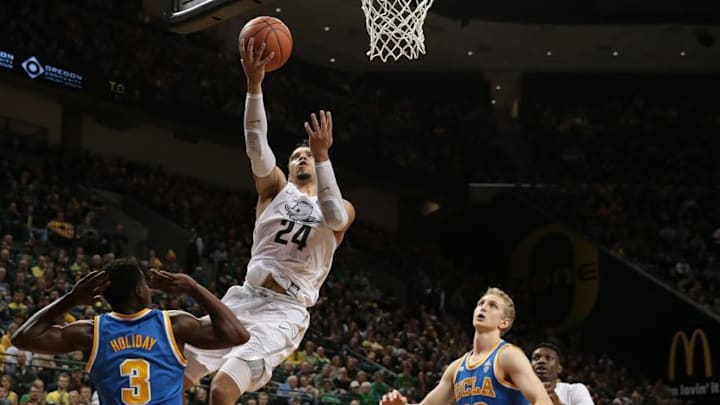With 28 seconds left and UCLA leading Oregon, 85-83, the Bruins’ top-rated freshman Lonzo Ball drove to the basket. He was defended by junior Dillon Brooks, the Ducks’ returning star who is still working his way back to full strength after missing the first three games of the season recovering from a foot injury.
Ball is largely a passer once he gets inside the 3-point arc — just one-third of his shots in the halfcourt are 2s, according to Hoop-Math — using his elite court vision to find an open teammate as the defense collapses around him, but as Brooks slid to cut off his driving lane, Ball spun over his left shoulder and lofted a layup over the outstretched arm of the Oregon forward.
The shot seemed like a dagger as it pushed UCLA’s win probability to 95 percent with 23 seconds remaining, according to KenPom.
With 16 seconds left, Brooks fired a pass from the left corner to freshman Payton Pritchard. The 6-foot-1 guard nailed a deep triple to bring the Ducks within one. They still needed a little luck. It came in the form of missed free throw. UCLA senior Bryce Alford, an 85.5 percent free throw shooter, clanked the front end of a one-and-one, giving Oregon one last chance.
Eight seconds left. Brooks kicks the ball ahead to Pritchard after rebounding the missed free throw. The freshman pushes it past halfcourt with the junior trailing. As they near the 3-point line, he drops the ball back to Brooks who uses a ball screen from Jordan Bell that creates just enough contact with Ball to give him space for a shot. Roles reversed, Brooks rises up for the game-winning 3-pointer — the contest’s real dagger — over Ball’s reaching arm to seal a much needed 89-87 win for Oregon.
“We executed a play we’ve run in practice to get a three and Dillon hit it,” head coach Dana Altman told the media after the game. The play, called “pop,” is a simple one, but on Wednesday, simple was enough.
Brooks’ game-winner is a welcome sign for an Oregon team that struggled to find a marquee win during non-conference play. Just a few months removed from making the Elite Eight, the Ducks were trounced by Baylor early in November without their star on the floor. In his first game back, Oregon fell to Georgetown as Brooks played just 13 minutes. Until Wednesday, there weren’t any other major resume-building opportunities.
*****
To understand why Oregon struggled early, you have to understand just how important Dillon Brooks is to what they do. One way to measure the effect of a player is to see how involved they are with the team’s offense. Two statistics, usage rate and assist rate, can help shed some light on that. Usage rate measures the percentage of possessions used by that player either in the form of a true shot attempt (field goal attempts adjusted for free throws) or turnover, while assist rate estimates the number of field goal makes the player assisted while he was on the floor.
Only 13 players in Division I have a usage rate and an assist rate that are both above 30 percent.

Only two of those players are on teams in a major conference. And only one of them plays on a team with a reasonable chance to make the Final Four. That player is Oregon’s Dillon Brooks.
Brooks’ ability to attack the basket off the bounce is paramount to the Ducks’ offensive success. He’s converting 63.9 percent of his non-transition shots at the rim, per Hoop-Math, and drawing an impressive 6.5 fouls per 40 minutes, per KenPom. His growing willingness to facilitate, though, opens up additional doors for Oregon.
The junior is averaging 5.6 assist per 40 minutes this season, up from 3.8 in 2015-16 while raising in his assist rate by over 11 percent. Although the Ducks aren’t much of an outside shooting team (31.7 percent), Brooks does well finding cutters heading to the basket and helping his team get high percentage looks.
Not only is Oregon reliant on Brooks to create for himself and others, the team is better off for it. Among players with at least 100 possessions of offense logged, no Ducks player matches Brooks’ value. With the 6-foot-5 forward on the court, Oregon is scoring 1.17 points per possession, according to Hoop Lens. That would be enough to push the Ducks from a team that currently ranks 70th in offensive points per possession into the top 10 nationally.
Add in the fact that Altman called on Brooks to defend Ball on the final possession and it’s not hard to understand why he was a consensus preseason All-American.
*****
For Oregon, led by Dillon Brooks, Wednesday marked a return to national relevance. The Ducks were a preseason top five team in the country, but had fallen out of favor after losing to Baylor and Georgetown.
It was somewhat understandable. This isn’t last year’s Oregon team. Without Elgin Cook and Dwayne Benjamin, the Ducks can no longer play the same type of active switching defense that pestered opponents into submission a season ago. The offense has also slipped, falling from 13th in adjusted efficiency last season to 42nd after the win over UCLA, per KenPom.
Still, the Ducks can always come back to Dillon Brooks. As a sophomore he led the team to the Elite Eight. As a junior, he’s being asked to carry an even heavier offensive load and has so far delivered magnificently. That’s enough to put Oregon back in the Final Four conversation, but Brooks won’t be looking that far ahead. There are other challenges on the horizon as he told the media after draining Wednesday’s game winner.
Next: 3 things we learned from UCLA-Oregon
“We’ve got to celebrate it for now, and then move on the another undefeated team, USC.”
Oregon plays the Trojans on Friday.
